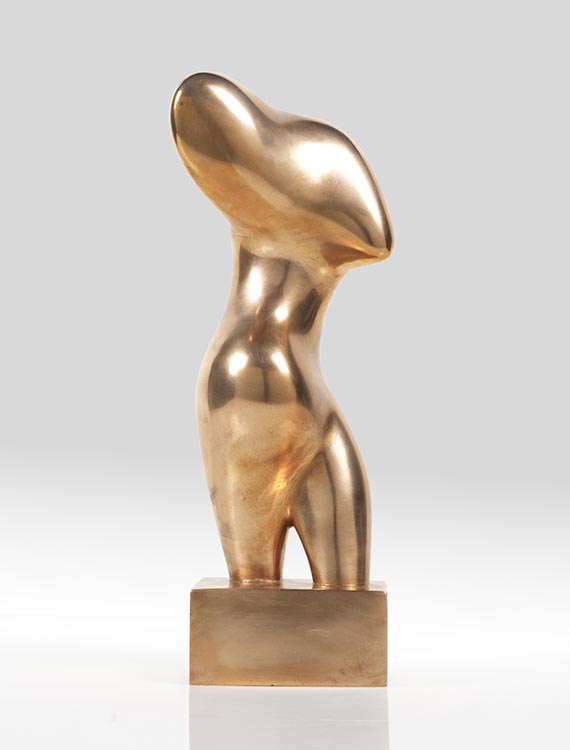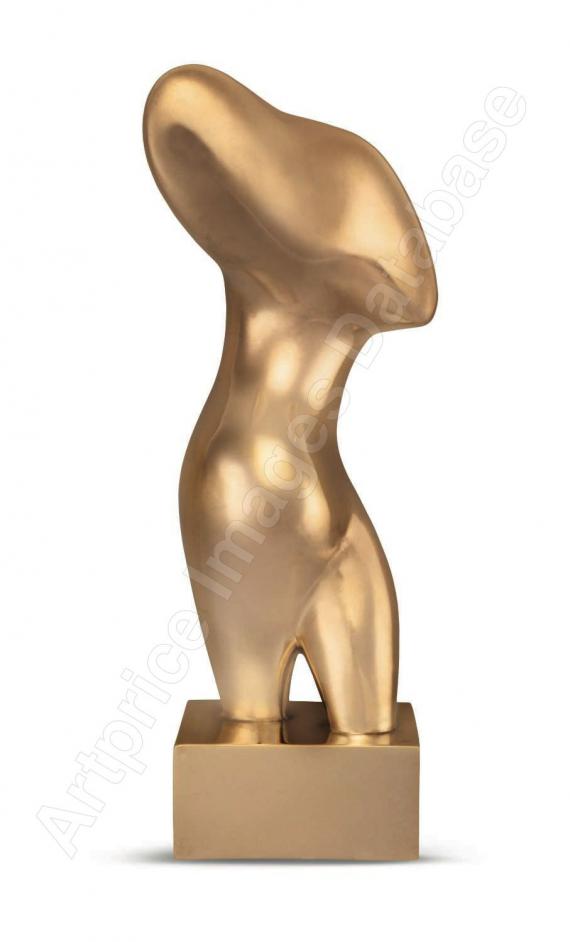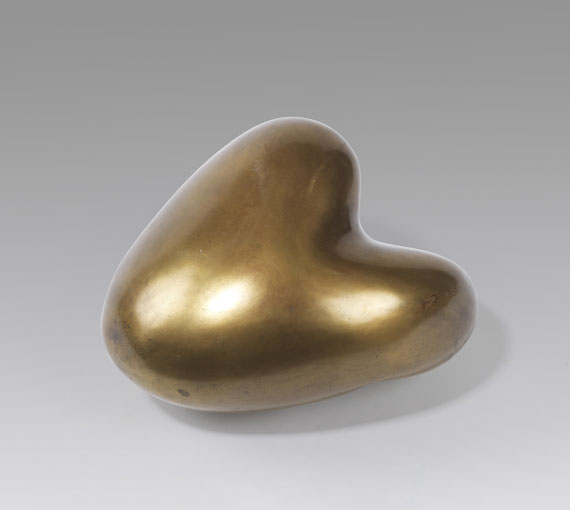Video
Back side
233
Hans (Jean) Arp
Torso, 1930.
Bronze, polished
Post auction sale: € 40,000 / $ 47,200
Torso. 1930.
Bronze, polished.
Copy 2/5 (probably cast in 1957), one of 6 known (1/5-5/5, 0/5) authorized casts. Height: 31 cm (12.2 in). [KA].
More works from the Max Niedermayer Collection, Limes-Verlag Wiesbaden, will be offered in the Evening Sale on June 6 and in the Day Sale on June 7, as well as in other auctions throughout the year.
• Impressive bronze after one of Hans Arp's earliest sculptures.
• With his biomorphic forms, Arp abstracts the human figure to create his characteristic “primordial forms.”
• Arp is considered a leading figure of the international avant-garde.
• Another cast is in the collection of the Arp Museum Bahnhof Rolandseck in Remagen.
• One of the most important recent exhibitions was “Rodin/Arp” (Fondation Beyeler, 2020–2021), in which Arp's work was presented in a fascinating dialog with that of Auguste Rodin.
The work is registered in the archives of the Arp Foundation. We are grateful to the Hans Arp and Sophie Taeuber-Arp Foundation for their kind support.
PROVENANCE: Dr. Max Niedermayer Collection (1905–1968), Wiesbaden.
Dr. Max Niedermayer Estate, Wiesbaden.
Private collection, Rhineland-Palatinate (acquired from the above in 1979).
In family ownership ever since.
LITERATURE: Arie Hartog, Hans Arp. Skulpturen, Eine Bestandaufnahme, Ostfildern 2012, catalogue no. 5, and p. 21 (illustrated)
On the original plaster cast from 1930, see: Carola Giedion-Welcker, Hans Arp, Stuttgart 1957, catalogue raisonné no. 5.
- -
Marguerite Valerie Schlüter, Briefe an einen Verleger (Letters to a Publisher). Max Niedermayer on his 60th birthday, Wiesbaden 1965, p. 194 and p. 210.
Bronze, polished.
Copy 2/5 (probably cast in 1957), one of 6 known (1/5-5/5, 0/5) authorized casts. Height: 31 cm (12.2 in). [KA].
More works from the Max Niedermayer Collection, Limes-Verlag Wiesbaden, will be offered in the Evening Sale on June 6 and in the Day Sale on June 7, as well as in other auctions throughout the year.
• Impressive bronze after one of Hans Arp's earliest sculptures.
• With his biomorphic forms, Arp abstracts the human figure to create his characteristic “primordial forms.”
• Arp is considered a leading figure of the international avant-garde.
• Another cast is in the collection of the Arp Museum Bahnhof Rolandseck in Remagen.
• One of the most important recent exhibitions was “Rodin/Arp” (Fondation Beyeler, 2020–2021), in which Arp's work was presented in a fascinating dialog with that of Auguste Rodin.
The work is registered in the archives of the Arp Foundation. We are grateful to the Hans Arp and Sophie Taeuber-Arp Foundation for their kind support.
PROVENANCE: Dr. Max Niedermayer Collection (1905–1968), Wiesbaden.
Dr. Max Niedermayer Estate, Wiesbaden.
Private collection, Rhineland-Palatinate (acquired from the above in 1979).
In family ownership ever since.
LITERATURE: Arie Hartog, Hans Arp. Skulpturen, Eine Bestandaufnahme, Ostfildern 2012, catalogue no. 5, and p. 21 (illustrated)
On the original plaster cast from 1930, see: Carola Giedion-Welcker, Hans Arp, Stuttgart 1957, catalogue raisonné no. 5.
- -
Marguerite Valerie Schlüter, Briefe an einen Verleger (Letters to a Publisher). Max Niedermayer on his 60th birthday, Wiesbaden 1965, p. 194 and p. 210.
Cast in 1957, Hans Arp's bronze “Torso” is emblematic of the artist's unique approach to the medium, a remarkable fusion of organic forms, and a profound exploration of metamorphosis. While the torso suggests the form of a human figure, it is not a direct depiction. Instead, it captures an evolving state, a moment in the ongoing process of becoming. The work is part of Arp's comprehensive exploration of abstract forms, in which his organic, gently curved, often biomorphic figures evoke an intimacy with nature. At the same time, they elude a direct mimetic representation. In 1955, Arp explained: “Art should dissolve in nature. It should even be confused with nature. But this should not be achieved through imitation, but through the opposite of naturalistic copying.” (Hans Arp, 1955, quoted from: Eduard Trier, Hans Arp. Skulpturen 1957-1966, Stuttgart 1968, p. IX).
Arp's “Torso” transcends the boundaries of representation and transformation through the fusion of sculpture and the poetic rhythm of nature. The sculpture is not merely a form frozen in time but an invitation to an ever-evolving dialogue between abstraction and nature, permanence and change. [KA]
Arp's “Torso” transcends the boundaries of representation and transformation through the fusion of sculpture and the poetic rhythm of nature. The sculpture is not merely a form frozen in time but an invitation to an ever-evolving dialogue between abstraction and nature, permanence and change. [KA]
233
Hans (Jean) Arp
Torso, 1930.
Bronze, polished
Post auction sale: € 40,000 / $ 47,200
Buyer's premium, taxation and resale right compensation for Hans (Jean) Arp "Torso"
This lot can be purchased subject to differential or regular taxation, artist‘s resale right compensation is due.
Differential taxation:
Hammer price up to 800,000 €: herefrom 32 % premium.
The share of the hammer price exceeding 800,000 € is subject to a premium of 27 % and is added to the premium of the share of the hammer price up to 800,000 €.
The share of the hammer price exceeding 4,000,000 € is subject to a premium of 22 % and is added to the premium of the share of the hammer price up to 4,000,000 €.
The buyer's premium contains VAT, however, it is not shown.
Regular taxation:
Hammer price up to 800,000 €: herefrom 27 % premium.
The share of the hammer price exceeding 800,000 € is subject to a premium of 21% and is added to the premium of the share of the hammer price up to 800,000 €.
The share of the hammer price exceeding 4,000,000 € is subject to a premium of 15% and is added to the premium of the share of the hammer price up to 4,000,000 €.
The statutory VAT of currently 7 % is levied to the sum of hammer price and premium.
We kindly ask you to notify us before invoicing if you wish to be subject to regular taxation.
Calculation of artist‘s resale right compensation:
For works by living artists, or by artists who died less than 70 years ago, a artist‘s resale right compensation is levied in accordance with Section 26 UrhG:
4 % of hammer price from 400.00 euros up to 50,000 euros,
another 3 % of the hammer price from 50,000.01 to 200,000 euros,
another 1 % for the part of the sales proceeds from 200,000.01 to 350,000 euros,
another 0.5 % for the part of the sale proceeds from 350,000.01 to 500,000 euros and
another 0.25 % of the hammer price over 500,000 euros.
The maximum total of the resale right fee is EUR 12,500.
The artist‘s resale right compensation is VAT-exempt.
Differential taxation:
Hammer price up to 800,000 €: herefrom 32 % premium.
The share of the hammer price exceeding 800,000 € is subject to a premium of 27 % and is added to the premium of the share of the hammer price up to 800,000 €.
The share of the hammer price exceeding 4,000,000 € is subject to a premium of 22 % and is added to the premium of the share of the hammer price up to 4,000,000 €.
The buyer's premium contains VAT, however, it is not shown.
Regular taxation:
Hammer price up to 800,000 €: herefrom 27 % premium.
The share of the hammer price exceeding 800,000 € is subject to a premium of 21% and is added to the premium of the share of the hammer price up to 800,000 €.
The share of the hammer price exceeding 4,000,000 € is subject to a premium of 15% and is added to the premium of the share of the hammer price up to 4,000,000 €.
The statutory VAT of currently 7 % is levied to the sum of hammer price and premium.
We kindly ask you to notify us before invoicing if you wish to be subject to regular taxation.
Calculation of artist‘s resale right compensation:
For works by living artists, or by artists who died less than 70 years ago, a artist‘s resale right compensation is levied in accordance with Section 26 UrhG:
4 % of hammer price from 400.00 euros up to 50,000 euros,
another 3 % of the hammer price from 50,000.01 to 200,000 euros,
another 1 % for the part of the sales proceeds from 200,000.01 to 350,000 euros,
another 0.5 % for the part of the sale proceeds from 350,000.01 to 500,000 euros and
another 0.25 % of the hammer price over 500,000 euros.
The maximum total of the resale right fee is EUR 12,500.
The artist‘s resale right compensation is VAT-exempt.
Headquarters
Joseph-Wild-Str. 18
81829 Munich
Phone: +49 89 55 244-0
Fax: +49 89 55 244-177
info@kettererkunst.de
Louisa von Saucken / Undine Schleifer
Holstenwall 5
20355 Hamburg
Phone: +49 40 37 49 61-0
Fax: +49 40 37 49 61-66
infohamburg@kettererkunst.de
Dr. Simone Wiechers / Nane Schlage
Fasanenstr. 70
10719 Berlin
Phone: +49 30 88 67 53-63
Fax: +49 30 88 67 56-43
infoberlin@kettererkunst.de
Cordula Lichtenberg
Gertrudenstraße 24-28
50667 Cologne
Phone: +49 221 510 908-15
infokoeln@kettererkunst.de
Hessen
Rhineland-Palatinate
Miriam Heß
Phone: +49 62 21 58 80-038
Fax: +49 62 21 58 80-595
infoheidelberg@kettererkunst.de
We will inform you in time.




 Lot 233
Lot 233 


